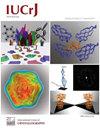通过极化中子散射从afp调制极化质子突出自由基位。
IF 3.6
2区 材料科学
Q2 CHEMISTRY, MULTIDISCIPLINARY
引用次数: 0
摘要
利用时间分辨中子散射研究了酪氨酸掺杂牛肝过氧化氢酶中的动态极化质子。虽然可以很好地模拟和理解带有有机Cr(V)配合物的标准动态核极化(DNP)体系中质子极化的演变及其通过绝热快速通道(AFP)方法的反转,但酪氨酸掺杂过氧化氢酶的实验将我们带入了极稀释顺磁体的世界,每cm3只有约1017个未配对电子。在这种情况下,DNP的强度与质子极化在T = 1k和B = 3.5 T时Pe = 0.35%的热平衡漂移相当。负DNP抵消了这种漂移,它被限制在非常接近自由基位置的质子中,通常在5 Å以内。相反,AFP在距离自由基较远的地方逆转质子的极化。偏振近质子区引起的中子散射的对比被AFP大大增强。此外,质子极化的扩散对磁性的不均匀性很敏感,就像过氧化氢酶分子中血红素的铁一样。简而言之,来自afp调制极化样品的极化中子散射为绘制自由基蛋白中质子极化的源和汇提供了一个极好的工具。本文章由计算机程序翻译,如有差异,请以英文原文为准。
Highlighting radical sites through polarized neutron scattering from AFP-modulated polarized protons
Selective nuclear spin reversal by the method of adiabatic fast passage is a way to order a system of dynamically polarized nuclei. Using polarized neutron scattering, it increases the visibility of sources and sinks of proton polarization in radical proteins. Notably, Tyr369 has been confirmed as a potential radical site in bovine liver catalase.
Time-resolved neutron scattering has been used to study dynamically polarized protons in tyrosyl-doped bovine liver catalase. While the evolution of proton polarization and its inversion by the method of adiabatic fast passage (AFP) in a standard dynamic nuclear polarization (DNP) system with organic Cr(V) complexes can be well modelled and understood, the experiments with tyrosyl-doped catalase lead us into the world of extremely dilute paramagnets with only about 1017 unpaired electrons per cm3. In this regime, the strength of DNP is comparable to the drift of proton polarization towards its thermal equilibrium of Pe = 0.35% at T = 1 K and B = 3.5 T. Negative DNP, which counteracts this drift, is confined to protons very close to the radical site, typically within 5 Å. In contrast, AFP reverses the polarization of protons at a larger distance from the radical. The contrast of a domain of polarized close protons giving rise to neutron scattering is considerably enhanced by AFP. Moreover, the spread of proton polarization is sensitive to magnetic inhomogeneities, like the iron of the heme of the catalase molecule. In short, polarized neutron scattering from AFP-modulated polarized samples provides an excellent tool for mapping sources and sinks of proton polarization in radical proteins.
求助全文
通过发布文献求助,成功后即可免费获取论文全文。
去求助
来源期刊

IUCrJ
CHEMISTRY, MULTIDISCIPLINARYCRYSTALLOGRAPH-CRYSTALLOGRAPHY
CiteScore
7.50
自引率
5.10%
发文量
95
审稿时长
10 weeks
期刊介绍:
IUCrJ is a new fully open-access peer-reviewed journal from the International Union of Crystallography (IUCr).
The journal will publish high-profile articles on all aspects of the sciences and technologies supported by the IUCr via its commissions, including emerging fields where structural results underpin the science reported in the article. Our aim is to make IUCrJ the natural home for high-quality structural science results. Chemists, biologists, physicists and material scientists will be actively encouraged to report their structural studies in IUCrJ.
 求助内容:
求助内容: 应助结果提醒方式:
应助结果提醒方式:


